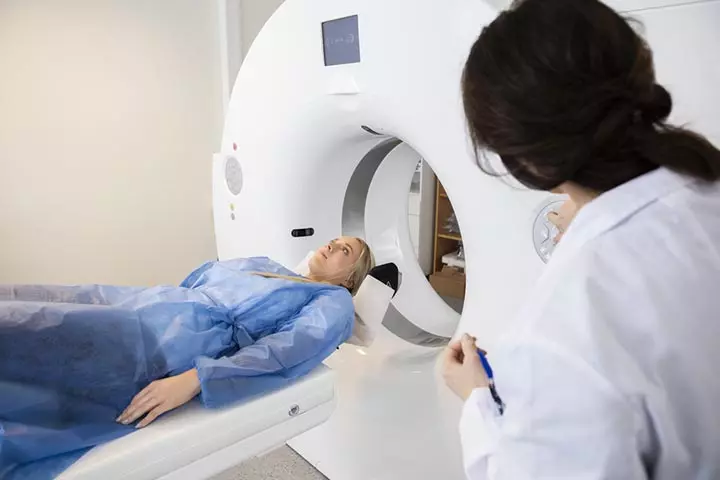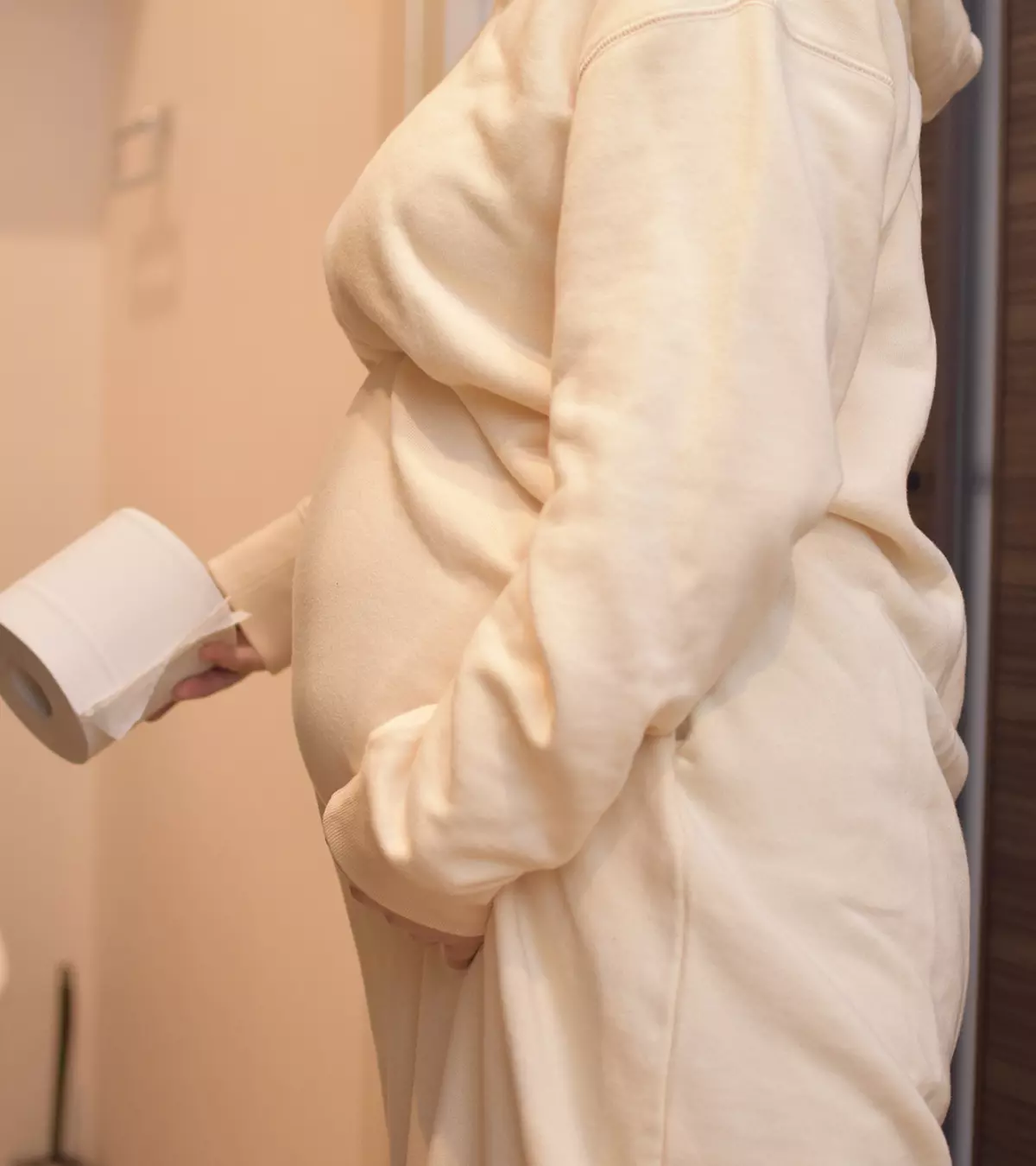
Image: Shutterstock
The protrusion of organs through weak muscles or tissues is called a hernia. Although uncommon, hernias after C-section surgeries may occur in some deliveries. The abdominal organs can protrude or herniate through the surgical incision after a C-section, called incisional hernia (1).

A prospective cohort study of over ten years of data showed that two out of every 1000 women who underwent cesarean delivery through transverse incision developed incisional hernias, requiring surgical interventions eventually (2).
Read on to know about the causes, symptoms, and treatment of hernia after C-section delivery.
Key Pointers
- Hernia after C-section is caused when organs protrude through weak muscles or tissues.
- Abdominal protrusion, pain, and constipation are some symptoms of hernia.
- Factors contributing to this condition may be a previous C-section, abdominal surgery, or diabetes.
- The condition can be treated through surgery.
- Maintaining an ideal weight and avoiding heavy lifting are a few ways to prevent hernia.
What Are The Symptoms Of Hernia After A C-Section?

Incisional hernias or ventral hernias are likely to manifest three to six months after childbirth surgeries such as cesarean delivery (1).
The symptoms of hernia after C-section may include
- Abdominal bulge: A bulge or protrusion of the abdominal muscles may appear near the site of the incision cut or surgery, and you may feel a lump in the abdomen while bowing down or lifting objects (3).
- Pain or discomfort: Pain or discomfort after a cesarean birth is common. However, faint or severe pain while coughing, sneezing, or lifting objects could also be a manifestation of a hernia (4).
- Nausea or constipation: When abdominal organs, such as the intestines, protrude due to incisional hernia, it can affect the digestive system. The displacement of the intestines can affect digestion and cause constipation and nausea (5).
What Are The Risk Factors Of Hernia?

Pregnant women rarely experience incisional hernia during recovery after cesarean delivery. The University of Copenhagen conducted a meta-analysis revealing that the incidence of incisional hernia following a C-section ranges from 0.0% to 5.6%. However, certain risk factors contribute toward its occurrence (4) (6):
- Previous cesarean births
- Previous abdominal surgery
- Overweight during or before pregnancy
- History of steroids, chemotherapy, or medications that can affect immunity
- Diabetes
 Research finds
Research findsHow Do Doctors Diagnose Hernia After A C-Section?

To diagnose a postoperative hernia, the doctor will first look for a bulge near the incision site. You may be asked to stand up and cough for the bulge to be distinctly visible. Imaging modalities, such as ultrasound, MRI, or CT scans, may be carried out to help locate the hernia and aid in surgery (4).
What Is The Treatment For Hernia After A C-Section?
The primary approach to treating an incisional hernia is surgical repair, which can be of two types depending on the severity of the symptoms and the protrusion (7).
- Open surgery: In this type of surgery, the patient is administered anesthesia, and a long incision is made in the groin. Then, the hernia or protrusion is pushed back into the abdomen. Finally, the abdominal wall is secured with either stitches or synthetic/biological mesh to strengthen the area.
- Laparoscopic surgery: In case the hernia is small, the doctor may perform laparoscopic surgery. A tube fitted with a camera is inserted through a small cut in the abdomen to help the doctor visualize the hernia and repair it using synthetic mesh.

Pain relief medication may be administered following the surgery, and the doctor may advise against lifting heavy objects or performing any strenuous activity after the surgery.
What Are The Complications Of Hernia Post C-Section?

Generally, incisional hernias are treated with surgery, and complications are rare but may be severe. The intestines may get trapped or stuck in the abdominal cavity, obstructing the blood supply, which is called strangulation. It can cause nausea, vomiting, and acute abdominal pain and lead to necrosis or death of the tissue (5).
Can You Prevent Hernia After A C-section?
The risk of hernia after a C-section can be reduced by maintaining a healthy weight, following a balanced diet, doing gentle exercises, avoiding heavy lifting, avoiding strained bowel movements, and consulting your doctor for chronic coughing or colds (8).
 Quick tip
Quick tipCan Hernia Recur After A Cesarean Delivery?
Recurrence of incisional hernias is a major complication that can occur years after the first surgery and may require another surgery. To reduce the risk of recurrence, avoid smoking and maintain a healthy weight (7). Also, follow your doctor’s instructions, watch for signs of complications, and attend follow-up appointments to ensure proper healing.
Frequently Asked Questions
1. What is the rate of occurrence for incisional hernia after a C-section?
Studies have reported an occurrence rate for incisional hernia after a C-section to be between 0.0 and 5.6 % (9)
2. When is an incisional hernia an emergency?
An emergency surgery may be required in the rare instance of an incisional hernia threatening to strangle (cut-off blood supply) a portion of the intestine (10).
3. How do I know if my hernia is strangulated?
You may experience pain and swelling if a hernia is strangulated. The pain worsens when lifting or straining. There may be additional bowel obstruction symptoms such as nausea, vomiting, and severe constipation. The skin around the herniated area may also appear reddish or dusky compared to the surrounding skin (11).
Even though a hernia after a C-section is rare, it is not unlikely, and the condition usually manifests around three to six months following cesarean delivery. The most common symptoms of this condition include a bulge in the abdomen and a feeling of nausea. If a woman is overweight or has had a history of abdominal surgeries or diabetes, it might increase her risk of having a hernia after a c-section. However, it can be treated with the help of surgery and followed by pain medications to manage the pain. Contact the doctor immediately if you feel any discomfort or severe pain after the surgery.
Infographic: What You Must Know About Hernia After A C-Section
Hernia can be painful and problematic if not treated on time. But what makes a new mom susceptible to developing the condition? If you are concerned about it, this infographic will brief you on the key attributes to know about it and help you understand and recognize the symptoms and the risk factors.
Some thing wrong with infographic shortcode. please verify shortcode syntax
Postpartum hernia is a common condition that can cause pain and discomfort. Learn about its causes, signs and symptoms, diagnosis and treatment in this video.
References
- Incisional hernia.
https://www.hopkinsmedicine.org/health/conditions-and-diseases/hernias/incisional-hernia - Anna J. M. Aabakke et al.; (2014); Incidence of Incisional Hernia after Cesarean Delivery: A Register-Based Cohort Study.
https://www.ncbi.nlm.nih.gov/pmc/articles/PMC4182598/ - About Your Abdominal Incisional Hernia Surgery.
https://www.mskcc.org/cancer-care/patient-education/about-your-abdominal-incisional-hernia-surgery - What is an incisional (ventral) hernia?
https://www.brighamandwomens.org/surgery/general-and-gastrointestinal-surgery/hernia/incisional-hernia - Ventral (Abdominal) Hernia.
https://www.hopkinsmedicine.org/health/conditions-and-diseases/hernias/ventral-abdominal-hernia - A. Shand et al.; (2015); Incisional hernia repair after caesarean section: a population‐based study.
https://www.semanticscholar.org/paper/Incisional-hernia-repair-after-caesarean-section%3A-a-Shand-Chen/c0f7783af83521ccf662e27b29ce1c5985b8625a?p2df - Ventral (Incisional) Hernia.
https://surgery.ucsf.edu/condition/ventral-incisional-hernia - Hernia.
https://my.clevelandclinic.org/health/diseases/15757-hernia - Cecilie B Paulsen et al.; (2019); Incisional hernia after cesarean section: A systematic review.
https://pubmed.ncbi.nlm.nih.gov/31785469/ - What is an incisional (ventral) hernia?
https://www.brighamandwomens.org/surgery/general-and-gastrointestinal-surgery/hernia/incisional-hernia - Alyssa Pastorino and Amal A. Alshuqayfi; (2025); Strangulated Hernia.
https://www.ncbi.nlm.nih.gov/books/NBK555972/ - Hernia.
https://my.clevelandclinic.org/health/diseases/15757-hernia
Community Experiences
Join the conversation and become a part of our nurturing community! Share your stories, experiences, and insights to connect with fellow parents.
Read full bio of Dr. Miguel Angel Razo Osorio
Read full bio of Aneesha Amonz
Read full bio of Rebecca Malachi
Read full bio of Reshmi Das

















